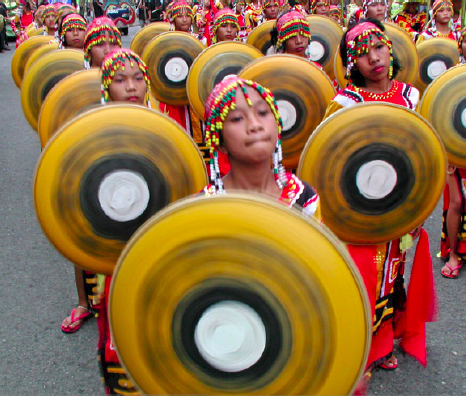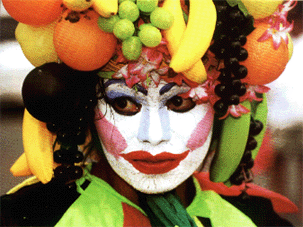
-
МјРЇСІИёСЖШИМі
-
 PASIGARBO SA SUGBO (Festival of Festivals)
PASIGARBO SA SUGBO (Festival of Festivals) 12,172
12,172 -
 Flores De Mayo in the Philippines
Flores De Mayo in the Philippines 11,725
11,725 -
 Ibalong Festival
Ibalong Festival 11,238
11,238 -
 Ati-atihan Festival10,928
Ati-atihan Festival10,928 -
 CARACOL FESTIVAL10,318
CARACOL FESTIVAL10,318 -
 Gayon Bicol Festival10,194
Gayon Bicol Festival10,194 -
 MAGAYON FESTIVAL10,130
MAGAYON FESTIVAL10,130 -
 LANZONES FESTIVAL9,797
LANZONES FESTIVAL9,797 -
 Pasigarbo sa Sugbo9,762
Pasigarbo sa Sugbo9,762 -
 Budbud Kabog Festival @Catmon, Cebu9,567
Budbud Kabog Festival @Catmon, Cebu9,567

It is a celebration of Good Harvest! This globally famous festival is a weeklong celebration and thanksgiving for natureЁЏs bountiful harvest. Kadayawan Festival is being celebrated every 3rd Week of August. A celebration of the plentiful harvests of fruits and orchids during the season. Kadayawan is derived from the prehistoric word ЁАmadayaw,ЁБ a warm and friendly greeting also used to explain a thing that is valuable, superior, beautiful, good, or profitable, ЁАKadayawanЁБ in Mandaya means anything that brings fortune, a celebration of life, a thanksgiving for the gifts of nature, the wealth of culture, the bounties of harvest and serenity of living. Ethnic tribes around Mt. Apo usually gathered during the harvest-time when they had a bountiful harvest to give thanks to their gods particularly the all-powerful Bathala (supreme God). According to legend, the occasion is noticeable by happiness, singing, and dancing, as well as offerings to their divine protectors.

The festival is celebrated in the month of August with floats of fresh flowers and fruits, and indak-indak sa kadalanan or street dancing in colorful costumes. A variety of tribes parade the streets with their tribal costumes and jewelry. The city of Davao comes alive every year in August when it holds it yearly harvest festival. The streets are adorned with local fruit & vegetables while people hold street dances with abandon for four days. The harbour is the venue for native & power boat races. Everybody fights for seats to watch the Horse Fighting wherein stallions fight each other over the rights to mate with a mare. The crowd is sometimes tracked by the horses if they get too close. The last day the street is full of costumed dancers dancing to the local beat & decorated floats with glamorous Mindanao girls as eye candy. It's a time of fun & abandon. The festivity is not complete without the Bya'Neng ng Kadayawan or the Miss Kadayawan beauty contest. There is also the horsefight, a tribal animal show similar to the bullfight in Spain.

History
The festival began from a government-initiated program called ЁАUnlad Proyekto DavaoЁБ in 1986, planned to unite the Davaoeños after the chaotic martial law years and to showcase the city as a peaceful and colorful place to visit and do business in. At the time, it was called ЁАApo Duwaling,ЁБa name created from the icons Davao was famous for: Mt. Apo, the country's highest peak; durian, the king of fruits; and waling-waling. The queen of orchids. Davao is also home of the majestic Philippine eagle, the national bird. In 1988, the festival was renamed ЁАKadayawan sa DabawЁБ by Mayor Rodrigo Duterte to celebrate the city's unique wealth in flowers, fruits, and ethnic culture.

Today, Kadayawan has transformed into a festival of festivals, the mother of may other festivals in the region as it honors DavaoЁЏs artistic, cultural and historical heritage, its past personified by the ancestral ЁАlumadsЁБ, its people as they celebrate on the streets, and its floral industry as they parade in full regalia in thanksgiving for the blessings granted on the city.
ЁАKadayawan sa DabawЁБ is an enriching experience with a difference as its explores the past, present and future of the Davaoeños, the Mindanaoans, the Filipinos. Its sights and sounds remain supreme. Be part of the experience.
ЁАDu-aw na sa Dabaw! Duyog sa Kadayawan! Maglingaw-lingaw ta!ЁБ

The term "Kadayawan" is derived from the Mandaya word ЁАmadayawЁБ, a warm and friendly greeting used to explain a thing that is valuable, superior, beautiful, good, or profitable.

Long time ago, DavaoЁЏs ethnic tribes residing at the foot of Mount Apo would converge during a bountiful harvest. This ritual serves as their thanksgiving to the gods particularly to the ЁАManamaЁБ (the Supreme Being).
Various farming implements, fruits, flowers, vegetables, rice and corn grains were displayed on mats as villagers give their respect and thanks for the year's abundance. Singing, dancing and offerings to their divine protectors are the highlights of this ritual.

- ЁЄfYGbJbhcBF

- ЁЄfYGbJbhcBF

- ЁЄfYGbJbhcBF

- ЁЄfYGbJbhcBF

- ЁЄfYGbJbhcBF

- ЁЄfYGbJbhcBF

- ЁЄfYGbJbhcBF

- ЁЄfYGbJbhcBF

- ЁЄfYGbJbhcBF

- ЁЄfYGbJbhcBF

- ЁЄfYGbJbhcBF

- ЁЄfYGbJbhcBF

- ЁЄfYGbJbhcBF

- ЁЄfYGbJbhcBF

- ЁЄfYGbJbhcBF




- ЁЄSaDEVEqmgq

- ЁЄSaDEVEqmgq

- ЁЄSaDEVEqmgq\'\"\\(

- ЁЄSaDEVEqmgqщ\'\"\\(

- ЁЄSaDEVEqmgq

- ЁЄSaDEVEqmgq

- ЁЄSaDEVEqmgq

- ЁЄSaDEVEqmgq

- ЁЄSaDEVEqmgq

- ЁЄSaDEVEqmgq

- ЁЄSaDEVEqmgq

- ЁЄSaDEVEqmgq

- ЁЄSaDEVEqmgq

- ЁЄSaDEVEqmgq

- ЁЄSaDEVEqmgq




- ЁЄqpvwYmzPrC

- ЁЄqpvwYmzPrC

- ЁЄqpvwYmzPrC

- ЁЄqpvwYmzPrC

- ЁЄqpvwYmzPrC

- ЁЄqpvwYmzPrC

- ЁЄqpvwYmzPrC

- ЁЄqpvwYmzPrC

- ЁЄqpvwYmzPrC\'\"\\(

- ЁЄqpvwYmzPrCщ\'\"\\(

- ЁЄqpvwYmzPrC

- ЁЄqpvwYmzPrC

- ЁЄqpvwYmzPrC

- ЁЄqpvwYmzPrC

- ЁЄqpvwYmzPrC














 ЧЪРкДхФФ ОпАЃЛѓДу ПРЧТ
ЧЪРкДхФФ ОпАЃЛѓДу ПРЧТ 11ГтПЌМг МвКёРкИИСЗ 1РЇ
11ГтПЌМг МвКёРкИИСЗ 1РЇ
 ГЛАд ИТДТ ОюЧаПј УЃБт
ГЛАд ИТДТ ОюЧаПј УЃБт
 ИЎОѓ ЧаБГ ЙцЙЎБт
ИЎОѓ ЧаБГ ЙцЙЎБт
 СжИЛПЁ ГЛАЁ ОЕ КёПыРК?
СжИЛПЁ ГЛАЁ ОЕ КёПыРК? УжАэАЁМККё РЬКЅЦЎ СёБтБт
УжАэАЁМККё РЬКЅЦЎ СёБтБт
 ЧіСіПЁМЕЕ ЧЪРкДхФФ!
ЧіСіПЁМЕЕ ЧЪРкДхФФ! ЧіСіПЁМ АЁДЩЧб
ЧіСіПЁМ АЁДЩЧб









 ЧЪРк ЦЏБо Ч§ХУ! ФСНУОюСі МКёНК
ЧЪРк ЦЏБо Ч§ХУ! ФСНУОюСі МКёНК



 АЁСЗПЌМіЗЮ ДйЧдАд ОзЦМКёЦМ
АЁСЗПЌМіЗЮ ДйЧдАд ОзЦМКёЦМ





























